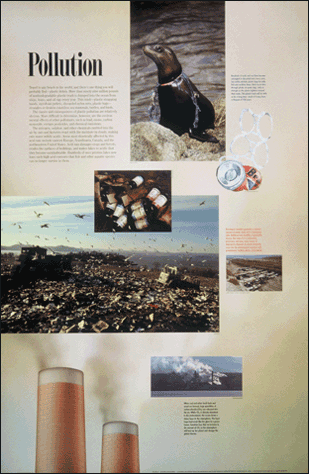 |

|


Travel to any beach in the world, and there's one
thing you will probably find-plastic debris. More than ninety-nine million
pounds of nonbiodegradable plastic trash is dumped into the ocean from
ships, boats, and oil rigs every year. This trash-plastic strapping bands,
styrofoam pellets, discarded nylon nets, plastic bags-strangles or drowns
countless sea mammals, turtles, and birds.
The causes and consequences of plastic pollution are relatively obvious.
More difficult to determine, however, are the environmental effects of
other pollutants, such as lead, ozone, carbon monoxide, certain pesticides,
and chemical emissions.
The nitrogen, sulphur, and other chemicals emitted into the air by cars
and factories react with the moisture in clouds, making rain water mildly
acidic. Areas most drastically affected by this acid rain include eastern
Europe, Scandinavia, Canada, and the northeastern United States. Acid
rain damages crops and forests, erodes the surfaces of buildings, and
makes lakes so acidic that they become uninhabitable. Hundreds of once
pristine lakes now have such high acid contents that fish and other aquatic
species can no longer survive in them.
|
| |

Encyclopedia of Pollution and Cleanup
*R-SIBL TD173 .M48
Water Quality Control Handbook
*R-SIBL TD420 .A45
Fate and Transport of Organic Chemicals in the Environment
*R-SIBL TD196 .O73 .N49

Computer Indexes
Applied Science and Technology Abstracts
Environmental Knowledgebase
Pollution Abstracts
Print Indexes
General Science Index*R-SIBL
Z7401 .G46
Biological Abstracts*R-SIBL QH301 .B37
Environment Abstracts*R-SIBL GF1 .E553
Pollution Abstracts *R-SIBL TD172.P65
|

The Effects of Noise on Man
by Karl D. Kryter
JSE 85-1915
The Search for the Ultimate Sink: urban pollution in
historical perspective
by Joel A. Tarr
JBE 99-2203
Pandora’s Poison: chlorine, health, and a new
environmental strategy
by Joe Thornton
JSE 00-807

|